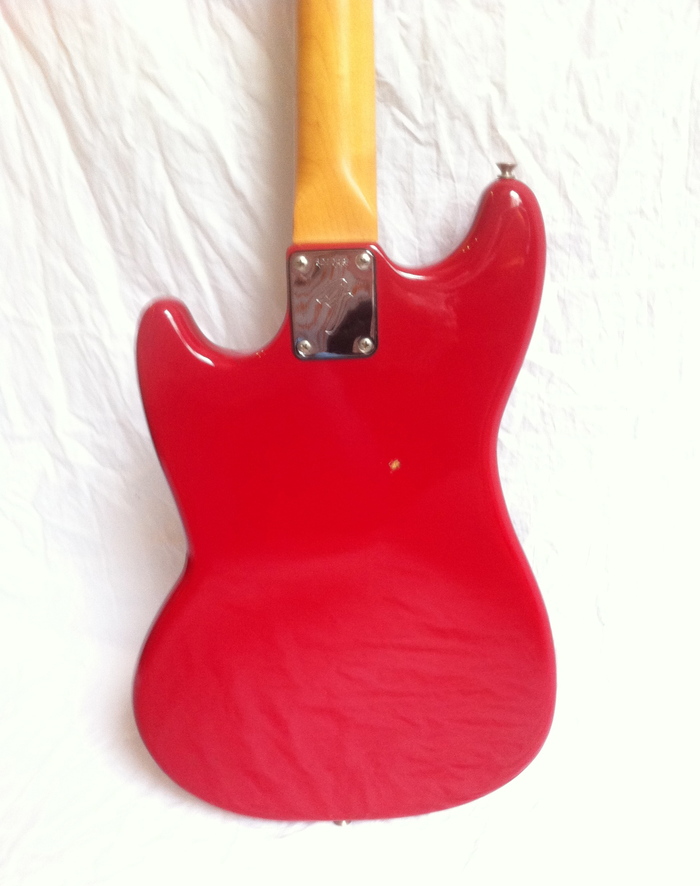
That is something that needs to be addressed. Note there is no fuse or thermal limiter in this model. The indicator lamp is a neon wired between neutral and the 120V tap on the power transformer, in this case. If there is anything else you need to know, now is the time to ask before I close it up again.Įdit: Added pics - lots of overlap!.

I'll take a couple of gut shots tomorrow and repost when I have them.
76 FENDER MUSICMASTER BASS FREE
Are you sure someone didn't replace the 6.3 v lamp and use a different supply for the lamp to free up more heater current for another tube or something?īob M.I have one of these on my bench right now. How much of the amp is left? If it's gutted you can use the iron and chassis to build whatever you want wit that tube compliment. What does it have? A neon lamp off of the mains. Thanks in advance for your on-point answers, I can't seem to find a schematic online for the 6AQ5 version of the Musicmaster Bass.
76 FENDER MUSICMASTER BASS TRIAL
My question: how is this pilot light for the 6AQ5 version wired? I don't want to ruin the part by trial and error so I though I'd ask once (or twice) and cut once. It's one of the changes made by Fender between the 6AQ5 version and the 6V6 version of this amp model, as they returned to the more typical pilot light set up when they updated this amp model to 6V6 power tubes. One of them is the pilot light which is different than the typical Fender 6.3 volt bulb and holder (and jeweled pilot lens). It has a few things still present in the chassis. Unlike the Duo Sonic, the neck pickup is a humbucker and the single coil is the bridge pickup.I've acquired a chassis for a Musicmaster Bass amp. It features 2 pickups, a single coil and a humbucker, and is the same as the 2020 Duo-Sonic other than the pickup configuration. In 2020, Fender released a special version of the Musicmaster for the Shawn Mendes Music Foundation. The Musicmaster was produced until 1982 when it, the Bronco and the Mustang were dropped in favor of the newer Fender Bullet models. This causes many modern surviving Musicmasters from this period to suffer from paint flaking off the body. Certain models of the Musicmaster, especially from between 19, were finished with a coat that reacted negatively with the base coat. These larger pickguards encompassed the entire control cavity which saved production costs for Fender. Later in the 70s the Musicmaster in its third incarnation was redesigned using the Bronco body and pickguard shapes. Around this same time the Fender Maverick was introduced using similar practices but with leftover Electric XII bodies and necks with Mustang bridges. In 1969, the Fender Swinger, a particularly interesting byproduct of this surplus was produced using the Musicmaster hardware, electrics, scratchplate, and the seldom ordered 22.5-inch necks, but with a modified Fender Bass V body. The Musicmaster in its second incarnation was still sold well into the 1970s however, using leftover parts until supplies ran out. The redesigned Musicmaster II alongside its stablemate the Duo-Sonic II lasted through 1969 before both models were dropped from production in favor of the more deluxe Mustang and new Fender Bronco. All three models were offered with the option of a 24-inch scale and 22-fret neck or a 22.5-inch scale and 21-fret neck the 24-inch scale proved to be the most popular of these options. The Mustang body was larger and slightly offset, and was fitted with a plastic pickguard but with the volume and tone controls mounted on a separate metal plate. In 1964, following the release of the Fender Mustang, both the Musicmaster and Duo-Sonic were redesigned using Mustang neck and body blanks.

At this time, the Musicmaster and Duo-Sonic both received a plastic pickguard in place of the previous anodized aluminum one, and a two-piece maple neck with a rosewood fingerboard. There was one major redesign of these two Musicmaster-bodied guitars, in 1959 when the entire Fender catalog was updated. The Duo-Sonic and Musicmaster also shared a single-piece maple neck and fingerboard, with a 22.5 inch scale length and 21 frets. Production of the Musicmaster began in late April of that year, using a body routed for two pickups to be common to the Duo-Sonic, which followed a little more than two months later. Prototypes were made in early 1956, followed by sales literature announcing both models. Musicians such as David Byrne and Liz Phair used a Fender Musicmaster.ĭesign work on the Musicmaster-and its two-pickup variant Duo-Sonic-began in late 1955 following a request from Fender Sales. It was the first 3/4 scale student-model guitar Fender produced.Ī Musicmaster Bass model was also put on the market.

The Fender Musicmaster is a solid body electric guitar produced by Fender. 1 proprietary single coil, offset variantĭesert Sand, Shaded Sunburst, Red-Mahogany, Olympic White, Daphne Blue, Dakota Red


 0 kommentar(er)
0 kommentar(er)
